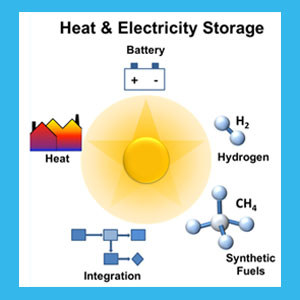Speaker
Mr
Michael Füeg
(University of Bern)
Description
The discovery of electrogenic bacteria has been a big breakthrough in the research of new energy technologies paving the way for the development of microbial fuel cells (MFC) [1]. MFCs run without combustion and yield a higher efficiency as compared to combustion engines [2]. The bacteria of genus Geobacter sulfurreducens (Gs), which produce the highest current densities of known pure cultures, represent the most thoroughly investigated family of electrogenic bacteria [3]. Recently, Soussan et al. showed that Gs are capable to reduce CO2 [4].
In-situ spectroscopic investigations, such as the attenuated total reflection-surface enhanced infrared absorption spectroscopy (ATR-SEIRAS) and the gap-mode surface enhanced Raman spectroscopy (GM-SERS), provide clear evidences that outer membrane cytochromes (OMCs) in Gs are responsible for the direct electron transfer to the respective electrode during electricity production, and that OMCs slowly denature when they are in close contact with a bare gold electrode [5]. The introduction of self-assembled monolayers (SAMs) as a linker represents a promising approach that prevents the denaturation of OMC and acts, at the same time, as an electron transfer mediator between OMCs and the gold electrode [6].
In this presentation, we show the influence of the ω-terminal anchoring group of the linker molecules on the current production and immobilisation of Gs on SAM-modified electrodes. As a preliminary result, electrochemical studies showed that carboxylate-terminated linker SAMs immobilised Gs cells efficiently, while a chronoamperometric study showed only an 10% current production of Gs biofilm as compared to biofilms electrostatically attached on a bare gold electrode.
An alternative strategy using silver nanoparticles formed and embedded within the Gs biofilms to enhance the electron transfer between Gs and the electrode is proposed.
1: D. R. Lovley, Annu. Rev. Microbiol. 2012, 66, 391-409.
2: C. Haynes, Journal of Power Sources 2001, 92, 199-203.
3: (a) D. R. Lovley, Curr. Opinion Biotech. 2008, 19, 564-571; (b) Energy Environ. Sci. 2011, 4, 4896-4906; (c) H. Yi et al., Biosens Bioelectron 2009, 24, 3498–3503.
4: L. Soussan, J. Riess, B. Erable, M.L. Delia, A. Bergel Electrochem. Commun. 2013, 28, 27-30.
5: A. Kuzume, M. Füeg et al. PCCP 2014, DOI: 10.1039/C4CP03357D
6: A. Kuzume, M. Füeg et al. Electrochim. Acta 2013, 112, 933-942.
Author
Mr
Michael Füeg
(University of Bern)
Co-author
Dr
Akiyoshi Kuzume
(University of Bern)

